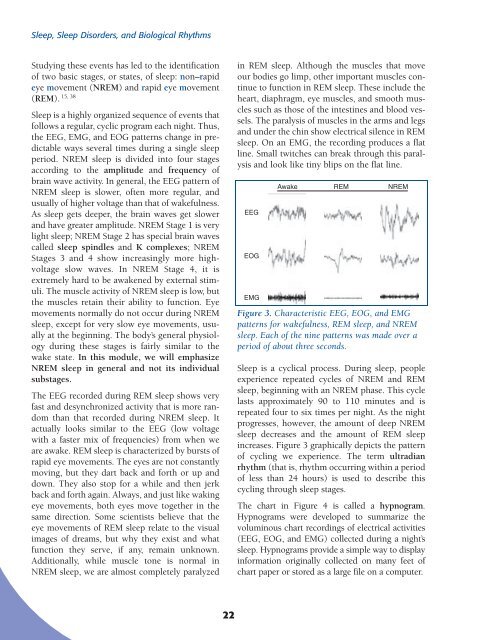Biological - NIH Office of Science Education - National Institutes of ...
Biological - NIH Office of Science Education - National Institutes of ...
Biological - NIH Office of Science Education - National Institutes of ...
You also want an ePaper? Increase the reach of your titles
YUMPU automatically turns print PDFs into web optimized ePapers that Google loves.
Sleep, Sleep Disorders, and <strong>Biological</strong> Rhythms<br />
Studying these events has led to the identification<br />
<strong>of</strong> two basic stages, or states, <strong>of</strong> sleep: non–rapid<br />
eye movement (NREM) and rapid eye movement<br />
15, 38<br />
(REM).<br />
Sleep is a highly organized sequence <strong>of</strong> events that<br />
follows a regular, cyclic program each night. Thus,<br />
the EEG, EMG, and EOG patterns change in predictable<br />
ways several times during a single sleep<br />
period. NREM sleep is divided into four stages<br />
according to the amplitude and frequency <strong>of</strong><br />
brain wave activity. In general, the EEG pattern <strong>of</strong><br />
NREM sleep is slower, <strong>of</strong>ten more regular, and<br />
usually <strong>of</strong> higher voltage than that <strong>of</strong> wakefulness.<br />
As sleep gets deeper, the brain waves get slower<br />
and have greater amplitude. NREM Stage 1 is very<br />
light sleep; NREM Stage 2 has special brain waves<br />
called sleep spindles and K complexes; NREM<br />
Stages 3 and 4 show increasingly more highvoltage<br />
slow waves. In NREM Stage 4, it is<br />
extremely hard to be awakened by external stimuli.<br />
The muscle activity <strong>of</strong> NREM sleep is low, but<br />
the muscles retain their ability to function. Eye<br />
movements normally do not occur during NREM<br />
sleep, except for very slow eye movements, usually<br />
at the beginning. The body’s general physiology<br />
during these stages is fairly similar to the<br />
wake state. In this module, we will emphasize<br />
NREM sleep in general and not its individual<br />
substages.<br />
The EEG recorded during REM sleep shows very<br />
fast and desynchronized activity that is more random<br />
than that recorded during NREM sleep. It<br />
actually looks similar to the EEG (low voltage<br />
with a faster mix <strong>of</strong> frequencies) from when we<br />
are awake. REM sleep is characterized by bursts <strong>of</strong><br />
rapid eye movements. The eyes are not constantly<br />
moving, but they dart back and forth or up and<br />
down. They also stop for a while and then jerk<br />
back and forth again. Always, and just like waking<br />
eye movements, both eyes move together in the<br />
same direction. Some scientists believe that the<br />
eye movements <strong>of</strong> REM sleep relate to the visual<br />
images <strong>of</strong> dreams, but why they exist and what<br />
function they serve, if any, remain unknown.<br />
Additionally, while muscle tone is normal in<br />
NREM sleep, we are almost completely paralyzed<br />
in REM sleep. Although the muscles that move<br />
our bodies go limp, other important muscles continue<br />
to function in REM sleep. These include the<br />
heart, diaphragm, eye muscles, and smooth muscles<br />
such as those <strong>of</strong> the intestines and blood vessels.<br />
The paralysis <strong>of</strong> muscles in the arms and legs<br />
and under the chin show electrical silence in REM<br />
sleep. On an EMG, the recording produces a flat<br />
line. Small twitches can break through this paralysis<br />
and look like tiny blips on the flat line.<br />
Figure 3. Characteristic EEG, EOG, and EMG<br />
patterns for wakefulness, REM sleep, and NREM<br />
sleep. Each <strong>of</strong> the nine patterns was made over a<br />
period <strong>of</strong> about three seconds.<br />
Sleep is a cyclical process. During sleep, people<br />
experience repeated cycles <strong>of</strong> NREM and REM<br />
sleep, beginning with an NREM phase. This cycle<br />
lasts approximately 90 to 110 minutes and is<br />
repeated four to six times per night. As the night<br />
progresses, however, the amount <strong>of</strong> deep NREM<br />
sleep decreases and the amount <strong>of</strong> REM sleep<br />
increases. Figure 3 graphically depicts the pattern<br />
<strong>of</strong> cycling we experience. The term ultradian<br />
rhythm (that is, rhythm occurring within a period<br />
<strong>of</strong> less than 24 hours) is used to describe this<br />
cycling through sleep stages.<br />
The chart in Figure 4 is called a hypnogram.<br />
Hypnograms were developed to summarize the<br />
voluminous chart recordings <strong>of</strong> electrical activities<br />
(EEG, EOG, and EMG) collected during a night’s<br />
sleep. Hypnograms provide a simple way to display<br />
information originally collected on many feet <strong>of</strong><br />
chart paper or stored as a large file on a computer.<br />
22

















